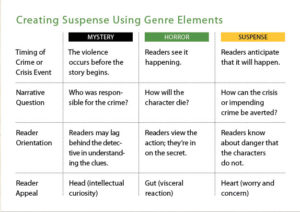How can you tell when a clock is really tense?
When it’s all wound up.
Creating tension by using some form of a limit is one of the easiest methods to ratchet up the tension in any manuscript, from novel to play to movie script. When many newer authors first hear about adding in a “ticking clock”, they immediately think of a suspense movie where the hero has to defuse the bomb before the time reaches zero. While this is a very common trope, it goes beyond that limited scope.
What’s a Ticking Clock?
 A ticking clock is an example of something that is constrained and must be dealt with, lest the characters have to deal with serious (and often dire) consequences if they fail. The entire plot can be constructed around the ticking clock, or it can be something smaller, such as a scene, where the protagonists have to get something done immediately.
A ticking clock is an example of something that is constrained and must be dealt with, lest the characters have to deal with serious (and often dire) consequences if they fail. The entire plot can be constructed around the ticking clock, or it can be something smaller, such as a scene, where the protagonists have to get something done immediately.
In honor of Carrie Fisher’s passing recently, I’ve been re-watching Star Wars. They have a whole slew of ticking clocks embedded within the script. For example, Han, Chewie, and Luke have to rescue Leia from the Death Star’s prison block because she is scheduled for execution. The ticking clock is the time limit they have to rescue her, and the consequence of failure is the character will be killed. Another example is Luke and Leia running away from the guards and getting trapped by the missing walkway. Under fire, Luke closes the door and blasts the controls, not thinking that they probably control the retracted walkway. The Stormtroopers are trying to open the door — that’s the ticking clock. Luke and Leia have to escape, or else they’ll be shot — that’s the consequence of failure. The audience was sitting on the edges of their movie theatre chairs in 1977, wondering if they’d make it. That’s tension.
Got Any Examples Without Using a Clock?
Sure! How about the old black and white movie “House on Haunted Hill” with Vincent Price? There are two versions of a ticking clock in that movie. There’s the usual version we talked about (the characters have to survive the night in a haunted house) plus the characters are getting killed off one by one. That’s a countdown where we’re wondering who the killer is — he or she must be with the house guests. Will we find out before they run out of living people? Is the killer even human?
I Write (Insert Genre Here). Can I Use a Ticking Clock?
 The ticking clock method of generating tension in a story can be used anywhere in fiction. Here’s some more examples:
The ticking clock method of generating tension in a story can be used anywhere in fiction. Here’s some more examples:
- Western: Sandra has to ride the last stagecoach to Cheyenne Wells to see her mortally wounded cavalry husband and tell him that she’s pregnant. The stagecoach is overcrowded and the occupants are dying one at a time. (Three clocks: a time limit for Sandra to reach her husband, else he dies without knowing he will be a father; the passengers are dying one by one so who is the killer; and the killer must be done before the stage reaches Cheyenne Wells.)
- Romance: Barb has to get to the church on time to prevent the wedding of the childhood sweetheart she’s still in love with to a manipulative, evil woman. (Clocks: Prevent the wedding; Barb telling him that she is in love with him before he’s married.)
- Science Fiction: A captain has to get to a planetary system in a disputed sector to rescue a plague research team because the local sun will go nova. Unfortunately, someone drops a vial and catches the plague. (Clocks: Get to the planet to save the team before the sun goes boom; will they be able to find a cure for the plague before they all die; can they deal with any enemies they meet on the way to the planet quickly enough to save the team.)
- Fantasy: Gnorl has enough magic to do three more powerful spells. Can he and Kahzoo, his ever-drunk swordfighting friend, save the princess before she is forced to marry the evil Prince Mal of Serenity? (Clocks: Limit of three spells; can Kahzoo stay sober long enough to fight; can they save the princess before Gnorl is out of power and Kahzoo’s liver goes supernova; prevent the wedding.)
Setting up a ticking clock is a particularly good way for beginning writers to add tension to their stories. Most writers are familiar with the general idea and they’ve probably seen enough of them in the movie theatres.
 The most important things to setting up a ticking clock/limited something scenario are:
The most important things to setting up a ticking clock/limited something scenario are:
- Something must actually be limited or constrained. Time is the most used example, but anything can be used as long as it is clear that there are a certain number and no more.
- The consequences of failing to complete the task must be severe. The audience must be concerned that the threatened character(s) or things (like a planet) will be irrecoverably damaged, hurt, or lost entirely.
- Never give the protagonists a reprieve. Keep the pressure on — in fact, ramp it up more as they go. Maybe the wedding is moved up a day or the plague ship is running out of fuel so they’ll have to land in a populated area to get some.
- Give the audience something when/if the protagonists do finish the task successfully. The heroine gets a kiss from her true love; the ship’s doctor gets promoted for finding the cure; the lady riding the stagecoach figures out who the killer is and stabs him through the heart with a hatpin. There should be some form of emotional release.
Look at the time! Get back to writing!

